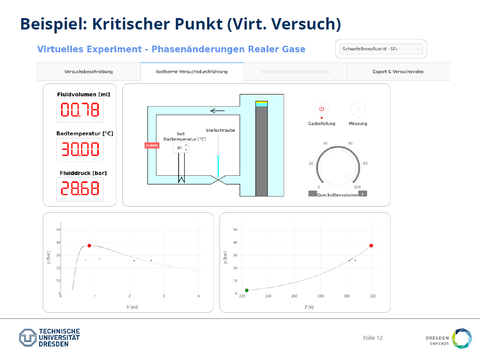Technical thermodynamics: Prof. Cornelia Breitkopf (#CB1)
Brief Description
The course is offered in the Mechanical Engineering Bachelor’s degree program and provides students with a theoretical understanding of thermodynamic systems and the skills to define and solve practical problems. Comprising a lecture (2 hours per week) and a practical, the missing training component left a large gap in the fundamental understanding of elementary relationships and approaches.
Keywords
- Fundamental lecture
- Thermodynamics
- Engineering

Technical thermodynamics: Prof. Cornelia Breitkopf (#CB1)
What makes this gem special?
The teaching plan includes lectures and a practical, which are supplemented by multiple online elements. These include videos and e-assessments to accompany the lectures as well as virtual training experiments. Furthermore, laboratory experiments conducted at the Chair serve as a basis that allow particularly motivated students to try and repeat them under real-world conditions in the lab.
The virtual training experiments are embedded in a test on OPAL. To prepare, students are asked to download the experiment instructions. Once the test has begun, three to four short introductory questions about the foundations of the experiment must be answered. After submission, students have the opportunity to find out whether their answers were correct as well as to receive constructive feedback and a section of literature to review if an answer was incorrect.
Subsequently, the actual experiment, which is stored on an external server but directly integrated in the OPAL test, begins. In one test task, the students receive initial values mirroring those in a real laboratory experiment (substance, mass, temperature...) and the link to the experiment at hand that opens in another tab. The students then use the regulators, drop-down menus etc. to set the given parameters and independently conduct the experiment according to the instructions. At the end, they can directly export their measured values and diagrams (e.g. as an Excel file). Students are asked for the properties obtained after evaluation in the OPAL test, and their responses are automatically corrected.
By integrating the entire experiment in OPAL, the teaching staff also receives feedback on students’ progress and understanding and can address any issues more specifically in class. Moreover, the students don’t need anything except for a web browser and an internet connection – no additional software is required.
Related links
Contact
Prof. Cornelia Breitkopf
Organizational unit
Faculty of Mechanical Science and Engineering, Institute of Energy Technology, Chair of Technical Thermodynamics
Course size
Over 100 students
Voting ID
#CB1
